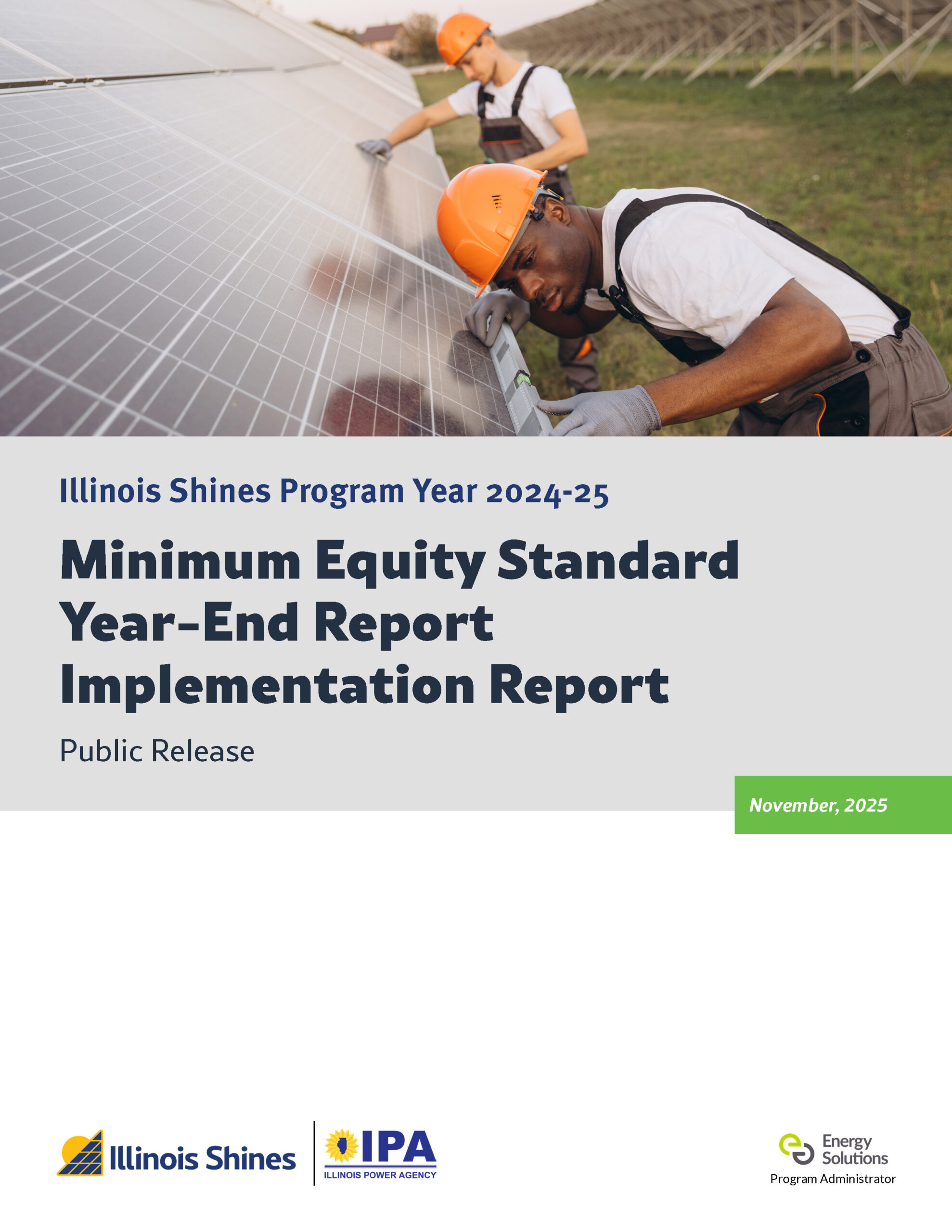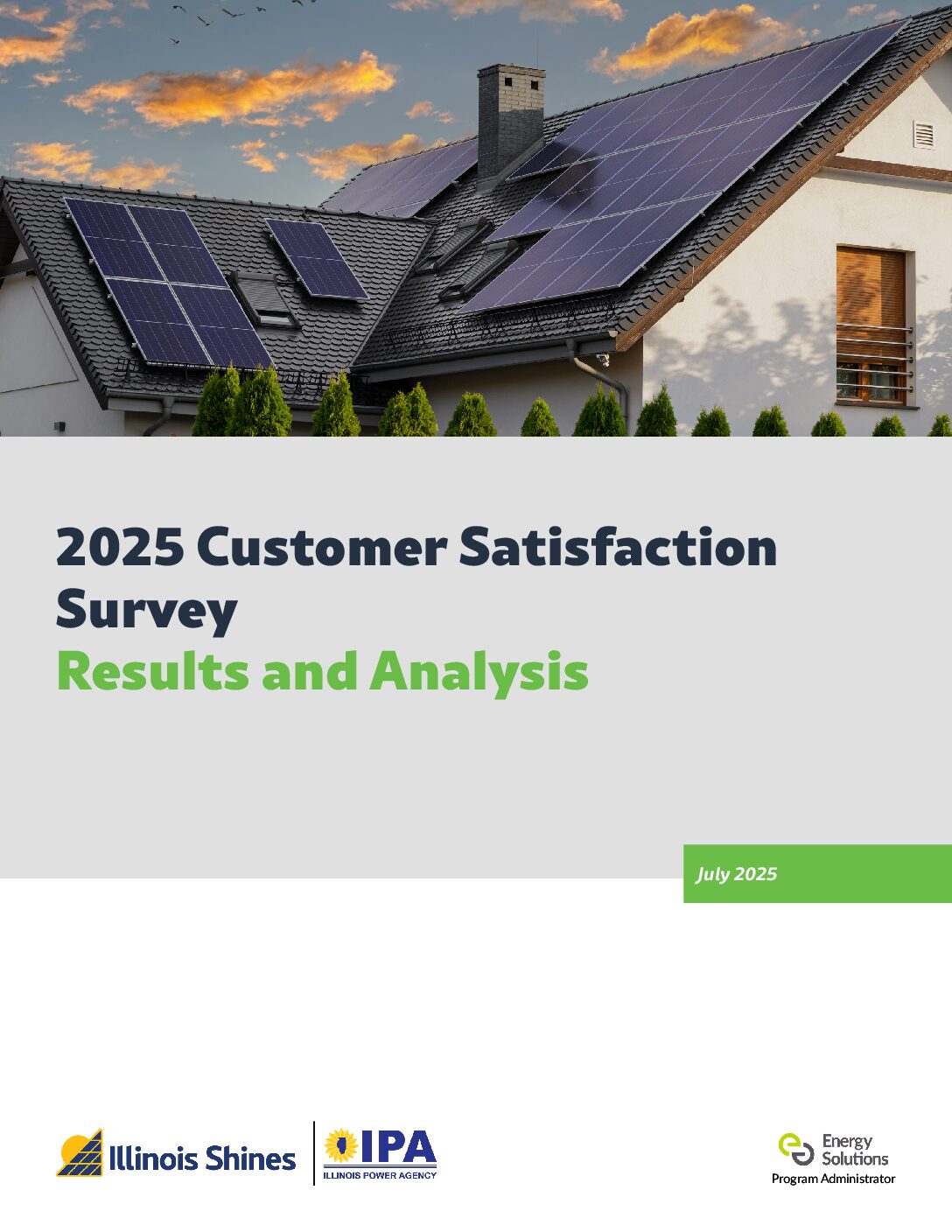About the Program
The Illinois legislature’s 2016 passage of the Future Energy Jobs Act (Public Act 99-0906 or FEJA) reflected significant collaboration and negotiation between energy companies, environmental groups, and consumer advocates, and mandated higher renewable energy targets in the state’s Renewable Portfolio Standard.
Illinois Shines, legislatively known as the Adjustable Block Program, supports the development of on-site solar (distributed generation) as well as community solar projects. The 2021 passage of the Climate and Equitable Jobs Act (Public Act 102-0662 or CEJA) supported significant expansion of Illinois Shines, and ultimately requires 100 percent use of renewable energy sources in Illinois by 2050, including provisions to make solar energy more available to low- and moderate-income communities. Following CEJA’s passage, Illinois Shines made the following changes:
Three new project categories
Public Schools, Community-Driven Community Solar, and projects submitted by Equity Eligible Contractors
Advances of capital
for Equity Eligible Contractor projects, to help reduce barriers to Program participation and help diversify the participating Approved Vendors
Updated consumer protection measures
to help protect consumers from unfair business practices, including introduction of a Consumer Protection Handbook that consolidated requirements for Approved Vendors and Designees
Prevailing wage requirements
for projects participating in Illinois Shines, to ensure that employees, contractors, and subcontractors are receiving local prevailing wages set by the Illinois Department of Labor
Collection of demographic data
from participating Approved Vendors and Designees, to support a future racial disparity study to measure the presence and impact of discrimination on minority businesses and workers in Illinois’ clean energy economy
The Equity Accountability System and the Minimum Equity Standard
requiring a growing percentage of Equity Eligible Persons make up the project workforce of participating Approved Vendors and Designees
Each Program Year brings continued progress and growth to Illinois Shines, through collaboration between Stakeholders, the Illinois Power Agency, and Energy Solutions, the Illinois Shines Program Administrator.
Visit the Reports & Data tab for more information about solar development through Illinois Shines.
Lifetime CO2 Offset by Energized Illinois Shines Projects*
The Illinois Shines projects that are energized will offset 12.1 million metric tons (MMt) of carbon dioxide equivalent emissions (CO2e) over their lifetimes. That’s equivalent to:

200M Trees
The carbon sequestered by 200,189,904 tree seedlings grown for 10 years

1.6M Homes
The CO2 emissions from 1,625,930 homes' energy use for one year

2.8M Vehicles
The greenhouse gas (GHG) emissions from 2,824,016 gasoline-powered passenger vehicles driven for one year
*Assuming 20-year project lifespan, 0.05% annual degradation rate, and average 15.47 capacity factor, and using data of projects energized by 5/31/2025
Illinois marginal emission rate factors identified from NREL’s Cambium data set, and CO2e emissions converted into impact equivalencies using EPA’s Greenhous Gas Equivalencies Calculator
About the Illinois Power Agency
The IPA was established in 2007 by Public Act 95-0481. Its goals and objectives are to accomplish each of the following:

1.
Develop electricity procurement plans to ensure adequate, reliable, affordable, efficient, and environmentally sustainable electric service at the lowest total cost over time, taking into account any benefits of price stability, for residential and small commercial customers of Ameren, ComEd, and MidAmerican. The electricity procurement plan is updated annually.
2.
Conduct competitive procurement processes to procure the supply resources identified in the procurement plan.
3.
Develop and implement a Zero Emission Standard Procurement Plan.
4.
Develop a Long-Term Renewable Resources Procurement Plan and implement the programs and procurements contained in the Plan, including the Illinois Shines (Adjustable Block Program) Illinois Shines and the Illinois Solar for All Program.
5.
Develop electric generation and co-generation facilities that use indigenous coal or renewable resources, or both, financed with bonds issued by the Illinois Finance Authority.
6.
Supply electricity from any Agency facilities at cost to one or more of the following: municipal electric systems, governmental aggregators, or rural electric cooperatives in Illinois.
About Illinois Shines
Illinois Shines makes going solar more affordable for more people across Illinois. With valuable incentives, step-by-step guidance, important consumer protection oversight, and an emphasis on equity, Illinois Shines helps everyone in Illinois be a part of the clean energy future, whether you install your own solar panels or not.
There are two main ways that Illinois Shines supports solar energy:
Illinois Shines provides incentives to solar vendors to develop DG and CS projects, which can be passed on to customers. Illinois Shines helps you find approved solar vendors, understand which project type might be right for you, and understand the financial considerations of these options.
Illinois Shines incentives for solar projects are provided through payments made for Renewable Energy Credits, or RECs, which are generated by participating Distributed Generation and Community Solar projects. RECs are widely used in energy markets and represent the environmental value of energy generated by renewable sources, including solar. With RECs, renewable energy sent to the utility grid is tracked, and a REC is issued when one megawatt-hour of electricity from a renewable energy source is added to the electrical grid. The Illinois Renewable Portfolio Standard (RPS) increases the use of renewable energy generated by projects such as solar panels and wind turbines. The RPS requires electric utilities to purchase RECs to meet their obligations to obtain defined portions of their electric power from renewable resources, thus providing financial value to RECs produced through the Illinois Shines program.
How does Illinois Shines utilize RECs to fulfill The Climate and Equitable Jobs Act’s goals for renewable energy generation?
Watch this video to learn more about RECs
- Each Program year, REC prices are set for the megawatts of electrical capacity that is made available across project categories.
- Solar providers calculate the estimated RECs that an individual Distributed Generation or Community Solar project will produce over a period of 15 to 20 years of operation.
- With Illinois Shines, DG customers agree to transfer ownership of RECs to their solar vendor, who then receives payment for them from utilities. Solar vendors may pass the value of these payments to the customer in the form of reduced installation costs or other methods agreed upon in a contract. Solar vendors will disclose the REC values for a project, along with system or subscription costs, to the customer, who can consider offers from multiple vendors. Projects and contracts may be structured in different ways by different vendors, allowing consumers to consider the offer that best meets their needs.
Available Program Documents
Illinois Shines is a state-administered program, developed and managed by the Illinois Power Agency, that incentivizes the development of solar energy projects in Illinois and supports the state’s goal of 40% renewable energy by 2030, 50% by 2040, and 100% by 2050.
The Illinois Power Agency was established in 2007 by Public Act 95-0481, and its goals and objectives include developing electricity procurement plans and a Long-Term Renewable Resources Procurement Plan, which includes the implementation of Illinois Shines (legislatively known as the Adjustable Block Program) and Illinois Solar for All.
The Agency’s Long-Term Renewable Resources Procurement Plan is prepared to conform with the Illinois Commerce Commission’s (ICC) Orders, in accordance with the Illinois Power Agency Act and the Illinois Public Utilities Act, and to meet the requirements of the Climate and Equitable Jobs Act. This statute expanded the Program vastly and was enacted in 2021.
The Illinois Shines Program Guidebook provides existing and prospective Program participants with necessary guidance about application requirements, participation requirements, Program processes, and other aspects of Illinois Shines. The Program Guidebook works in conjunction with the Illinois Power Agency’s Long-Term Plan to outline Program requirements for Approved Vendors and their subcontractors. It is reviewed and updated periodically to reflect changes in law and/or orders of the ICC, or the development of other requirements through separate comment and requirement publishing processes.
The Consumer Protection Handbook provides consumer protection requirements for Approved Vendors and Designees who participate in either Illinois Shines and/or Illinois Solar for All, and for projects of any type or size, unless otherwise indicated. The requirements apply to Approved Vendors and is relevant to their affiliates, employees, contractors and subcontractors, agents, installers, marketers, customer service liaisons, or any entity acting in any way on the Approved Vendors’ behalf in connection with, including all Designees.





